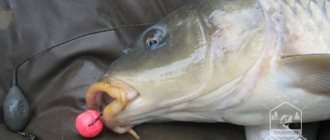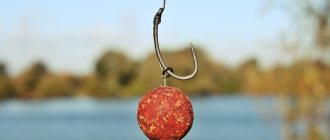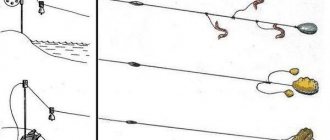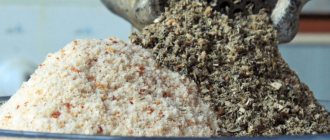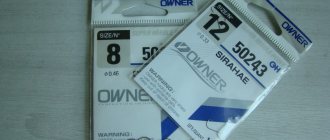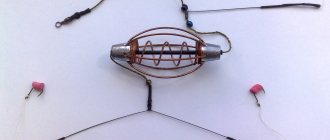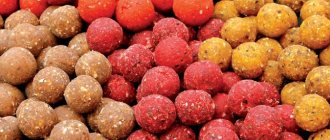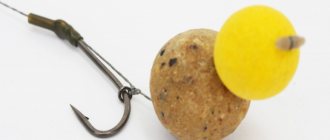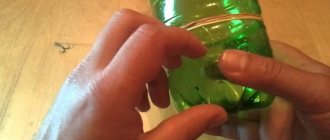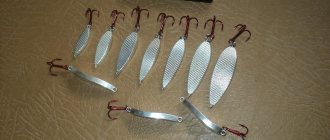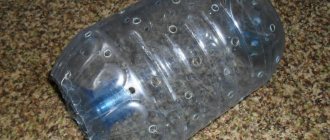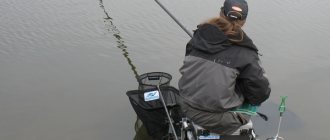How to plant boilies
- Take a piece of fishing line (about 30 cm long) and tie a loop at one end.
- Use a special needle to pick up the loop you have made and place the boilie on the leash.
- After this, a stopper is inserted into the loop to secure the bait.
- Next, holding the boilie between your thumb and forefinger, begin winding the line around the shank of the hook.
- After making 7-8 turns, you need to pass the end of the fishing line through the eye of the hook.
- By tightening the knot, you can attach the leash to the main fishing line.
Making boilies yourself: recipes
You can prepare boilies for carp fishing yourself.
To do this you will need the following ingredients:
- Wheat flour – 200 g.
- Powdered milk – 200 g.
- Semolina – 200 g.
- Chicken egg – 7 pcs.
The eggs must be thoroughly beaten in a separate bowl. Dry ingredients are mixed in another container. Add beaten eggs to the dry mixture in small portions with constant stirring. Then knead the dough with your hands until it reaches a consistency where it can be easily separated from your fingers.
Then the dough is rolled out into “sausages” with a diameter of about 1 cm. The sausages are cut into cubes 1 cm long. A ball is rolled out of each cube by hand.
The further process of making boilies depends on the purpose of this bait.
The sinking bait is prepared as follows:
- Preparing sinking boilies
An enamel pan with a volume of 3 liters is placed on the stove. - The pan is filled with water to 2/3 of its volume and brought to a boil.
- The balls are placed in a colander and lowered into hot water.
- The boilies are boiled for 2 minutes, then removed from the pan and placed on a cloth that is laid on a flat horizontal surface.
Boilies must be dried at room temperature for at least 8 hours.
If you need to make a floating bait, then the sequence of actions will differ significantly from the preparation of sinking boilies:
- The prepared balls are laid out on the oven tray so that they do not touch each other.
- Bake in the oven at +200°C for about 0.5 hours.
- Then the boilies must be laid out on a flat surface and allowed to cool.
When the boilies have cooled completely, they can be used for their intended purpose.
If fishing is planned in the near future, then boilies are stored in any solid container that does not absorb moisture. If it is necessary to store the nozzle for more than 3 days, then the boilies are placed in the freezer of the refrigerator.
Dusting boilies for carp
Boilies of this type are not subject to heat treatment. Dust boilies for carp are made without the use of eggs (the place of the binding component is taken by syrups, honey, molasses) and are simply dried. After the bait gets into the water, it begins to gradually dissolve, shedding one layer after another. If high-quality attractive components are added to the bait, such boilies will immediately attract the attention of carp swimming nearby.
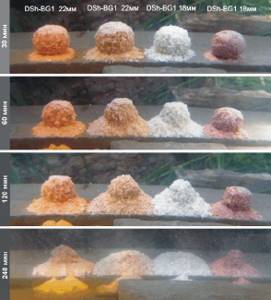
What are carp boilies (types and characteristics)
Boyle is a vegetable bait for catching carp and other peaceful fish. Made on the basis of dough mixed with rye, corn or semolina flour, with the addition of various components that enhance the aroma, taste properties of the nozzle, and color it in the required color.
After production, the mixture is formed into balls with a diameter of 0.5 to 3 cm or a cylinder is made, which is cut into measured pieces. Then the future bait is boiled in boiled water for some time, dried in air, and then stored in sealed bags or in the refrigerator.
Note! In proper conditions, boilies can be stored for a long time without losing their performance characteristics and attractiveness to fish.
As a result, the angler receives catchy carp baits with a solid structure and a pleasant aroma. They can be any color, and the choice of tone depends on the conditions at the fishing site, the preferences of the fish, the degree of illumination and transparency of the water.
Boilies, whether made independently or purchased in a store, must be mounted in a certain way and delivered to the fishing point. The nozzle holds well in the equipment, does not require frequent changes, and cuts off small things, attracting commercial-sized specimens.
According to their working properties, carp boilies are divided into the following types:
- floating;
- drowning;
- suspenders;
- dusty.
Floating boilies work above the bottom. They are relevant when the carp does not look for food in the ground, but collects it higher, or when fishing on a soft muddy structure. When making them, the cooking time is reduced than for sinking nozzles, so that more oxygen bubbles remain in the dough.
Dusty boilies leave an attractive cloud of turbidity behind them, so the fish can see them from a long distance. They are obtained by adding milk powder, breadcrumbs, and other small fractions to the dough. One of the disadvantages of such bait is that it attracts small things, which can interfere with full fishing for large individuals.
Hooks for catching carp with boilies
The size of the hooks may vary, depending on the size of the boilies and the desired catch. When choosing hooks, you need to pay attention to the strength and sharpness of the products.
In most cases, carp are hooked on their own, and therefore the fleshy jaw breaks through not after a strong hook, but under the weight of the fish itself. That is why the hook must be very sharp and reliable.
The best option is forged hooks with a short shank. Ideally, the distance from the shank of the hook to its sting should be approximately 1/3 or 1/2 the size of the boilie.
Fishing process and features
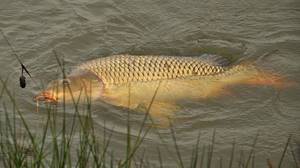
Before you start fishing for carp, you should determine the habitat of the fish. When fishing, it is recommended to take several types of bait balls. To begin with, you need to feed the fishing area; for this purpose, you can use pre-prepared bait or purchased bait. They are mixed with water and clay and made into small balls; it is enough to throw 4-5 balls.
The next step is the first cast with a boilie. The rod is mounted on a special holder, and a bell can be attached to the fishing line. If the carp starts to try the ball, the alarm on the shore will let you know about it.
Here you should be patient, carefully take the rod in your hand and wait for a strong jerk. As soon as the fish swallows the bait whole, you can begin to bring it to the shore. There is no need to rush, as carp is a life-loving fish, it will fight to the end. You should tire him out a little and only then take him ashore.
If there is a large enough carp on the hook, it is better to pull it out of the water using a landing net. Thus, the likelihood of the fish breaking off is reduced.
Recommendation: to begin with, it is better to use balls of small diameter so that the fish approach the bait more actively.
Catching carp always brings satisfaction to the angler, especially if a decent trophy is caught on the hook.
When catching it, the following points should be taken into account:
- The fishing spot must be properly and well fed.
- When catching this fish , you should be quiet, as the fish is very shy and sensitive to any sound.
- In summer , the likelihood of catching a big fish increases, as carp loves warm water.
- More often , carp can be found in shallow water.
- A landing net should always be in the angler’s arsenal if he goes hunting for this type of fish.
- Carp should be fished out gradually, without rushing.
- to let the line slack , as this can lead to breakage of the tackle.
Depending on the season
Summer is the best time of year to catch carp.
In warm water, the fish becomes more active, its appetite grows and therefore it swallows boilies with pleasure. During this period, it is at a depth of 1.5-4 meters. For boilies, it is better to use plant ingredients such as peas, corn, and bread.
In the fall, carp should be lured with something nutritious. For this, animal baits may be suitable - worms, bloodworms.
The balls must also contain animal components. The amount of flavorings must be reduced or not used at all.
Color of boilies for carp

It is still not known for sure whether the color of the boilie really matters. Be that as it may, for bottom fishing in reservoirs with a clean bottom, it is recommended to use light-colored baits.
In the middle layers of water they fish with red, orange, yellowish boilies, which, according to legend, can attract the attention of carp not only with their smell, but also with their appearance.
For bait, boilies similar to those used directly as bait are used, that is, the colors, sizes and, above all, smells of the baits must be the same.
Popular installation methods
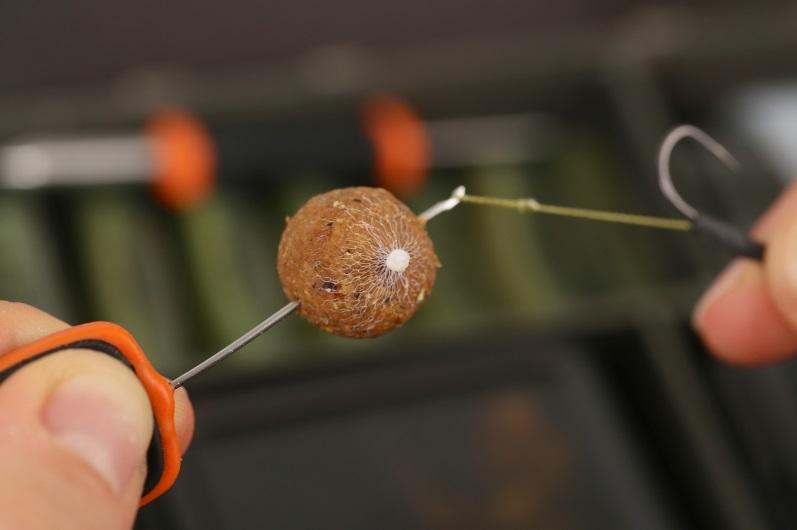
Correct installation of boilies for carp fishing is the basis for success in a foray into a pond. Experienced fishermen use hair. It makes it possible to reliably hook the bait without putting it on the hook, and present it in the most realistic way, so the fish has no doubt about its natural origin.
Hair installation is a simple equipment that can be implemented in different ways. Main varieties:
- rotating;
- on a ring (reverse strike);
- knotless;
- with loop;
- on a clip.
Let's look at some of them, their advantages, application features and implementation on ponds, lakes and rivers.
Rigid equipment
According to reviews from professional carp anglers, rigid mounting is the most versatile. Western colleagues call it “stiff rig”. Suitable for attaching floating and sinking boilies. It is distinguished by reliable fixation of the nozzle, its attractiveness and natural appearance for the fish.
Rigid equipment is made on a braided cord with or without coating. The operating properties of the installation prevent the fish from spitting out the bait, which affects fishing productivity and minimizes the number of idle bites.
Knotless installation
The simplest equipment for catching carp with boilies, which can be recommended to beginners as a basic setup for mastering this type of fishing. Among Western fishermen it is called “knotless knot rig”. To implement it, no additional accessories are required, except for a heat-shrinkable tube that protects the unit and facilitates the correct position of the nozzle in the water.
Knotless installation is suitable in any conditions. It works in still waters and currents, can be used on muddy and hard ground, and is suitable for sinking and floating boilies. It is often used when it is necessary to quickly assemble equipment without unnecessary labor costs and auxiliary elements.
We recommend reading: Bait for perch in winter
Blow-Back Rig
This method of mounting bait involves the use of a ring, which performs several important functions:
- increases the degree of freedom of the nozzle, enhancing its natural appearance;
- thanks to the free position, the hook, once in the carp’s mouth, turns at the right angle, digging into the fish’s mouth;
- when the victim tries to get rid of the hook, the ring hits its eye, ensuring more reliable penetration of the sting into the fish’s mouth.
Can be performed on fishing line and braided cord. Recommended for advanced fishing.
Types of flavors
In order for a homemade boilie to be of interest to wary fish, it must emit a smell that is attractive to carp. You can give the nozzle the necessary aroma using various additives.
- Since ancient times, when fishing for carp, fishermen have used dry spices and spices that can be found in the kitchen. They can be successfully added during the preparation of boilies. A good result is obtained by adding cinnamon powder to the dough at the rate of 15 g of spice per 1 kg of mixture. Anise drops or crushed anise seeds in small doses also activate fish biting. Ground red pepper becomes an interesting flavoring addition. For 1 kg of dough pour 1 tbsp. spoon of spice.
- Recently, dips have become fashionable flavoring additives. These are aromatic liquids that can be used to make boilies or dip the bait into them immediately before casting. Professionals speak flatteringly about the developments of Richworth. For 1 kg of dough only 5-7 ml of dip is required. According to some carp anglers, homemade boilies with this aroma work better than ready-made baits from the same company. An interesting pungent smell is obtained when using liquid flavors from the Mistral company at the rate of 3 ml of dip per 1 kg of dough.
Advantages and disadvantages of the nozzle
Benefits of using boilies
Boilies have two advantages:
- this is a very tasty bait that attracts carp and carp much better than any other bait;
- as mentioned above, small fish do not bother you when fishing with boilies , so this is an excellent bait for targeted hunting for trophy specimens.
Flaws
The disadvantages of boilies include their high price . Of course, if you use them only as a nozzle, the costs will not be so great. But if you feed with boilies, you will need a lot of them. You can also use ordinary crumbly bait in balls , but then small fish will also approach the fishing spot.
Reference! You can cook boilies yourself, but then the disadvantage is that their preparation takes a lot of time and requires a fairly large number of ingredients.
